Sony Cybershot DSC-H9 Review
Sony Cybershot DSC-H9 Introduction
The Sony Cybershot DSC-H9 boasts some of the most advanced specifications of any current digital camera. With a stabilized 15X optical zoom lens, a 3" LCD screen, an 8 megapixels image sensor, a maximum ISO of 3200 and full manual control, this ultra-zoom has a lot of appeal. Add to that its relatively light weight and compact form factorThe H9 is smaller than most cameras with 12X optical zoom. and you get a very interesting digital camera. To round off the specifications, the H9 is equipped with a DVD-quality movie mode, night-shot capability and output to HDTV.
Important features of the Sony Cybershot DSC-H9 are:
- 15X Optical zoom, equivalent to 31-465mm.
- Optical image stabilization.
- Full manual controls: P, S, A and M modes.
- Aperture range: F2.7 (wide) F4.5 (tele) to F8.
- Shutter speed range: 1/4000 to 30 seconds.
- ISO: 80, 100, 200, 400, 800, 1600, 3200 and Auto (80-800).
- Exposure compensation: -2..+2 stops, 1/3 stop increments.
- White-Balance: auto, daylight, cloudy, fluorescent, incandescent, flash and custom.
- Metering: multi-segment, center-weighed and spot.
- Auto focus: single, continuous and monitor.
- Focus: multi-point focus, center-focus, selectable focus-point and manual focus.
- Flash mode: auto, forced, off, slow sync, with or without redeye.
- Unlimited 640x480 30 FPS movie mode with zoom and sound.
- 2.2 FPS Continuous drive, up to 100 frames.
- 3 Image exposure bracketing, 1/3-1 EV steps.
- Night shot images and video in complete darkness.
- Wireless remote capable and included in most areas.

Sony Cybershot DSC-H9 Suitability - What is it good for?
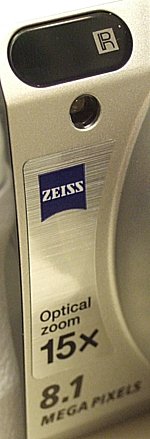 As an 8 megapixels digital camera, the Sony H9 is expected to produce prints at least 12"x16" in size. The 15X stabilized zoom starts at a 31mm equivalent focal-length and goes up to 465mm. This zoom range is a bit wider and a bit longer than most ultra-zoom cameras, thus covering most common focal-lengths up to super-telephoto. Such a long zoom is ideally suited for wildlife photography and is an asset for macro and street photography. In terms of macro, the H9 can get as close as 1cm (0.4") from its subject when the lens is at its widest, capturing a very small area. Since the H9 goes wider than most digital cameras, it is even an asset for architecture photography.
As an 8 megapixels digital camera, the Sony H9 is expected to produce prints at least 12"x16" in size. The 15X stabilized zoom starts at a 31mm equivalent focal-length and goes up to 465mm. This zoom range is a bit wider and a bit longer than most ultra-zoom cameras, thus covering most common focal-lengths up to super-telephoto. Such a long zoom is ideally suited for wildlife photography and is an asset for macro and street photography. In terms of macro, the H9 can get as close as 1cm (0.4") from its subject when the lens is at its widest, capturing a very small area. Since the H9 goes wider than most digital cameras, it is even an asset for architecture photography.
With a full set of manual controls including manual exposure, semi-automatic exposure, custom white balance, manual focus and metering options, the Sony Cybershot DSC-H9 is quite suitable for creative photography. Additionally, two automatic modes and several scene modes allow for point-and-shoot photography. A powerful top-mounted pop-up flash serves to illuminate subjects in low-light and provide fill-flash to reduce contrast in bright light. The wide-range of ISO, from 80 to 3200, makes the H9 usable for outdoor and indoor lightIncandescent. Finally, there is a Night-Shot mode, usable for still images and movies, which allows photography and filming in complete darkness, although with some important restrictions.
Since available shutter-speeds go from 1/4000s to 30s, the H9 can be used in very low-light - using a tripod, of course - and for shooting fast moving subjects. Even though the H9 has a continuous drive mode running at 2.2 FPS, the LCD and EVF do not keep up enough to reliably capture a decisive moment. Since the H9 can capture up to 100 frames continuously, performances which are relatively still can be followed extensively.
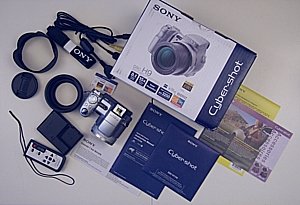 The Sony H9 has a high-quality 640x480 30 FPS movie mode which is now typical of modern digital cameras. Unlike most digital cameras, this one allows its zoom to be used during filming. In movie mode, the camera zooms slower and refocuses slowly on its subject to avoid recording the sound of its internal motors. The movie mode also allows live exposure-compensation and manual focusing during recording. This makes the H9 one of the most capable digital cameras for movie recording.
The Sony H9 has a high-quality 640x480 30 FPS movie mode which is now typical of modern digital cameras. Unlike most digital cameras, this one allows its zoom to be used during filming. In movie mode, the camera zooms slower and refocuses slowly on its subject to avoid recording the sound of its internal motors. The movie mode also allows live exposure-compensation and manual focusing during recording. This makes the H9 one of the most capable digital cameras for movie recording.
Sony Cybershot DSC-H9 Usability - How easy is it to use?
At first sight, the Sony Cybershot DSC-H9 shows stylish curves among a relatively simple design. This ultra-zoom digital camera feels surprisingly light considering its 15X optical zoom lens. It is also relatively small. Even most cameras with a shorter 12X optical zoom are larger and heavier. Note that the only camera with a longer zoom, the Olympus SP-550 is actually smaller than the H9. The H9's light weight makes it quite portable but does not feel so sturdy. Larger ultra-zoom cameras such as the Panasonic DMC-FZ30, feel considerable more solid.
The H9 has a tiltable LCD screen which, although it adds versatility for shooting at odd angles, contributes to making the camera more fragile. The hinge does seem more solid than some tiltable LCD screens from Fuji but not as sturdy as those from Canon. For a nearly identical but more solid camera, Sony has the Cybershot DSC-H7. The differences are a fixed 2.5" LCD instead and no Night-Shot feature.
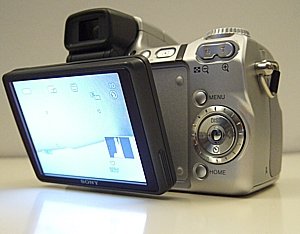
Design wise, the Sony H9 is reminiscent of a miniature DSLR with a deep hand-grip, an angled shutter-release, protruding lens barrel and rotating mode dial. The grip is deep and mostly comfortable once the optimal position is found. The key is to hold the camera at an angle so that the forefinger lands on the shutter-release and the thumb falls on the zoom controller. This way, it is possible to hold the camera tightly without having the metal eyelet for the neck-strap dig into your hand.
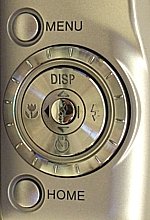 Unlike the H5 which
had a front-mounted control-wheel, the H9 uses a rotating dial
which surrounds the 4-way controller to change exposure parameters,
ISO sensitivity and focus modes. Being able to change ISO
sensitivity without entering the menu system is an improvement over its predecessor.
The rotating dial is easy and comfortable to use while holding
this digital camera with two hands. One handed operation does
not feel secure because the zoom controller and the rotating dial
are far enough from each other that going from one to the other
requires significantly shifting your grip. This is not so important,
but it is worth noting, particularly since the H5 did not have
this problem.
Unlike the H5 which
had a front-mounted control-wheel, the H9 uses a rotating dial
which surrounds the 4-way controller to change exposure parameters,
ISO sensitivity and focus modes. Being able to change ISO
sensitivity without entering the menu system is an improvement over its predecessor.
The rotating dial is easy and comfortable to use while holding
this digital camera with two hands. One handed operation does
not feel secure because the zoom controller and the rotating dial
are far enough from each other that going from one to the other
requires significantly shifting your grip. This is not so important,
but it is worth noting, particularly since the H5 did not have
this problem.
The rear side of the H9 is dominated by a high-resolution 3" LCD, leaving very little room for anything else. The LCD has excellent visibility in most lighting conditions. Even in direct sunlight, the subject is distinctively visible. In low light, the LCD gains up well. When moving the camera, the LCD refreshes at a good rate. However, when using the continuous drive, the LCD becomes blank between shots. This makes it difficult to track moving subjects.
To accommodate such a large LCD, Sony had to pack numerous controls into a small area. While this is admittedly better than removing them, the placement of some controls is problematic. The 4-way controller which is used for menu navigation, changing display modes, changing flash mode, toggling macro mode, activating a self timer is too low, making it difficult to use while maintaining a solid grip on the camera. These controls are prone to accidental activation. It actually happened quite a few times during testing. Lastly, the power and playback buttons are so flush that they are nearly impossible to press with gloves on.
Still on the subject of controls, the zoom controller is easy to use and its pressure-sensitivity is efficient for zooming over such a large range. The harder you press, the faster it zooms. Behind the shutter-release are easily accessible buttons for changing metering modes and drive modes. These two buttons are very easy to use while shooting without shifting your grip.
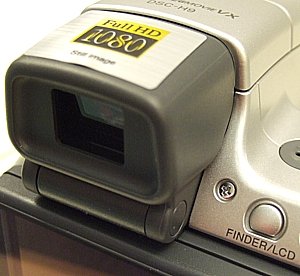 The Sony Cybershot DSC-H9 also includes a tiny low-resolution
EVF. Unfortunately, it can only be described as the worst EVF
we have ever seen. Its low-resolution means that subject details
are hard to make out and overlaid information is hard to read.
Also, the EVF on our production unit had a strong blue tint to
it, thus showing rather poor color accuracy. Another regression
compared to the H5 is that the EVF no longer protrudes from the
rear of the camera. This makes it very easy to leave nose marks on
the LCD while using the EVF.
The Sony Cybershot DSC-H9 also includes a tiny low-resolution
EVF. Unfortunately, it can only be described as the worst EVF
we have ever seen. Its low-resolution means that subject details
are hard to make out and overlaid information is hard to read.
Also, the EVF on our production unit had a strong blue tint to
it, thus showing rather poor color accuracy. Another regression
compared to the H5 is that the EVF no longer protrudes from the
rear of the camera. This makes it very easy to leave nose marks on
the LCD while using the EVF.
In use, the Sony H9 is straight forward. Most controls behave just as expected. The shutter-release is quite sensitive with a slight halfway point for locking exposure and focusExcept when in continuous-focus mode. In shooting mode, pressing a direction on the 4-way controller rotates through various settings. Up is for the display mode. Right is for the flash mode. Down sets a 10 second timer, a 2 second timer or no timer at all. Left toggles macro mode on and off.
The 4-way controller is also used for navigating the menu system which is entered and exited using the Menu button. Strangely, the center button is neither used to confirm menu selection nor to dismiss the menu system. Instead the center button is used to toggle between changing a setting and selecting the setting to change. There is a second menu system which is activated by a button labeled Home. Both menu systems are easy to navigate with a clear and refined appearance. However, having two separate menu systems means having to remember which option is in which menu.
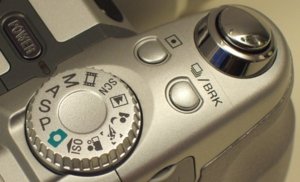
When off, the Sony H9 is protected by a sturdy lens cap which holds securely to the lens barrel. When turning the camera on, the lens will push the lens cap off as it extends. On the lens cap, there is also a small eyelet which can be used to strap the cap to the camera. The lens cap also fits on the supplied lens hood adapter.
The camera is equipped with a tripod mount which is in-line with the camera's center rather than the lens' center. This is ideal for stability but not for shooting panoramas without special gear. Also on the bottom-side, there is a combined battery and memory compartment door. The H9 accommodates a proprietary lithium-ion battery for power and Memory Stick Duo cards for storage. Note that Sony requires the use of a Memory Stick Pro Duo card for recording movies of the highest quality. Memory Stick Duo cards are priced higher than other common formats such as Secure Digital and Compact Flash. This must be factored into the camera's total cost. The Sony Cybershot DSC-H9 comes with a very slow charger which takes over 5 hours to fully charge a single battery. Sony conveniently sells a much faster changer as an optional accessory. A small bug that we found is that our production H9 stangely did not display the histogram for rotated images.
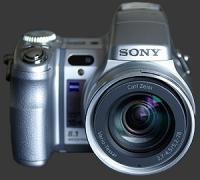 |
Please Support Neocamera
All information on Neocamera is provided free of charge yet running this website is a huge endeavor. Purchases made via affiliate links found throughout the site help keep it running and up-to-date. There is no additional cost to you, so please consider buying via these links to our affilates:
If you found any information on this site valuable and did not purchase via our affiliate links, please considering donating via PayPal:
Any amount will be greatly appreaciated. Thank you for your support!
Sony DSC-H9 Highlights

Sensor-Size: 6 x 4mm

Actual size when viewed at 100 DPI
| 8 Megapixels Ultra Zoom | ISO 80-3200 |
| 15X Optical Zoom | Shutter 1/4000-30s |
| Built-in Stabilization | Full manual controls |
| 0.20" Built-in EVF 200K Pixels | Custom white-balance |
| 2 FPS Drive, 100 Images | Spot-Metering |
| 640x480 @ 30 FPS Video Recording | Lithium-Ion Battery |
| 3" LCD 230K Pixels | Memory Stick Duo, Internal Memory |
Updates
2024.11.18

Best 2024 Photography Gifts for Every Budget
Great gifts for photographers and photo enthusiasts selected for every budget among the best products of 2024.
2024.08.07

Eye Protection Tips for Professional Photographers
The four main considerations for professional photographers regarding eyewear.
2024.07.14

Fujifilm X100VI Review
Flagship fixed-lens compact digital camera with a 40 MP sensor and Image-Stabilization, a first for the series. Retro design featuring dual control-dials, plus direct ISO, Shutter-Speed and EC dials. Its hybrid viewfinder can switch between EVF and OVF mode.
2024.05.09

Fujifilm GFX100 II Review
Flagship 102 Megapixels Medium-Format Mirrorless Digital Camera with 8-Stop 5-Axis IBIS, 8 FPS Drive, 8K Video and 400 MP Super-Resolution capture in a weatherproof and freezeproof body with dual control-dials and dual memory-card slots.
2024.04.03

Fujifilm X-T5 Review
Newest Fujifilm flagship boasting a 40 MP APS-C sensor, 5-axis IBIS with 7-stop efficiency, 15 FPS continuous drive, 6.2K Video capture, dual control-dials and dual SDXC UHS-II slots in a sturdy weatherproof and freezeproof body.
2023.11.20

Best Digital Cameras of 2023
Find out which are the Best Digital Cameras of 2023. All the new Mirrorless Digital Cameras from entry-level to high-end professional.
2023.07.10

Fujifilm X-H2 Review
40 Megapixels APS-C Hybrid Mirrorless Digital Camera with 7-stop IBIS. Fastest shutter ever and 8K video capture. Large builtin EVF with 0.8X magnification and 5.8 MP, plus an Eye-Start Sensor. Packed with features and large number of controls in a weatherproof and freezeproof body.
2023.05.07

Sony FE 20-70mm F/4G Review
Review of the unique Sony FE 20-70mm F/4G lens. The optical zoom of this lens spans ultra-wide-angle and medium focal-length coverage, making it one of the most versatile Full-Frame lenses on the market.
2023.01.15

Huion Inspiroy Dial 2 Review
Review of the Huion Inspiroy Dial 2 tablet, a medium sized drawing surface with dual dials and customizable buttons. Connects via USB-C or Bluetooth 5.0 with Windows, Linux and Android support.
2022.12.08

How to Pack for a Photo Trip
Find out how to pack for a travel photography trip, carry your gear safely while meeting airline regulations.
2022.11.13

Best Digital Cameras of 2022
The best digital cameras of 2022. A short list of the most outstanding models in their respective categories. Choose one for yourself or as a gift.
2022.09.21

Pentax DA* 60-250mm F/4 SDM Review
Review of the Pentax DA* 60-250mm F/4 SDM, the constant-aperture telephoto zoom with the highest zoom-ratio on the market.










